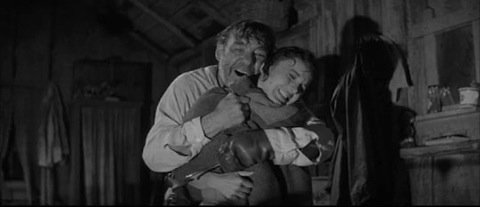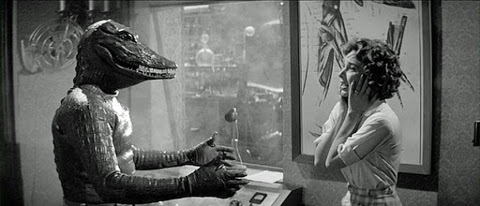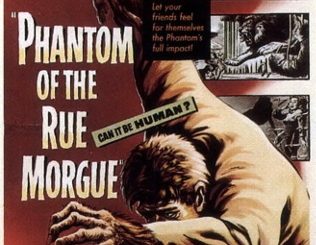The Alligator People (1959)
Directed by: Roy Del Ruth
Written by: Charles O'Neal, Orville H. Hampton, Robert M. Fresco
Starring: Beverly Garland, Bruce Bennett, George Macready, Lon Chaney Jr.
USA
AVAILABLE ON BLU-RAY AND DVD
RUNNING TIME: 74 mins
REVIEWED BY: Dr Lenera
SPOILERS!
Jane Marvin, a nurse at the Webley Sanatorium, agrees to become a subject in a series of hypnotic experiments. However, once under hypnosis, she reveals that her real name is Joyce Webster and proceeds to tell a remarkable story, beginning when she marries war veteran Paul Webster who then vanishes while on their honeymoon. After months of trying, she discovers an address that he had when he was at college, and heads to a plantation mansion in the Louisiana swamps. But nobody there seems to have even heard of Paul. Secrets are clearly being hidden, and who’s the disfigured man who comes in at night to play the piano?…..
It’s always good to watch a ‘B’ movie for a few laughs, and sometimes you come across a gem where instead of chuckling at what’s taking place on screen you’re hooked. The Alligator People is a strange one. It has quite a strong downbeat atmosphere positively reeking of Southern Gothic which holds back any laughter for quite lengthy periods, aided by terrific cinematography from Karl Struss and performances which take the script seriously. However, it’s also a film where, for example, the heroine runs through a swamp during a rainstorm wearing high heels, only for her heels to change into sneakers in the long shots, so every now and again there’s still something to mock. Perhaps more to the point though is the film’s structure which all-but-cripples it. We get lots and lots of moody build-up – and there’s nothing wrong with that, I like lots and lots of moody build-up – but then suddenly a load of stuff happens in ten minutes – and then it’s all over. The small budget probably required that the film be short, as well as the fact that it was put into production purely so that The Return Of The Fly would have a suitable film to be programmed with, but it feels as if main screenwriter Orville H. Hampton, aided by Charles O’ Neal and an uncredited Robert M. Fresco who actually did the first draft, overdid it and realised that he had to suddenly curtail the story he’d written, which he does in a very unsatisfying way. His main inspiration, of course, was The Fly [much like he would go on to rehash The Seventh Voyage Of Sinbad for Jack The Giant Killer], and a few months later the same year you had the similarly themed The Wasp Woman. Stories where scientists use things from animals and accidentally create a monster were indeed very common, perhaps beginning in 1944 when a werewolf was created by stupidly injecting a man with wolf blood in The Mad Monster. Don’t these people of science have any common sense?
The titles take place over a lengthy track down the winding river of a swamp. We can tell it’s a set, but it’s a very good set and raises some hopes that this production might have some quality. Cut to two scientists talking about one of them “having a problem with a young girl”. The “young girl” is a nurse who works in the same place called Jane, and under hypnosis she’s been saying some strange things. As she says that her name is really Joyce and that she’s married, I wondered if this was an attempt to cash in on the Bridey Murphy case. It’s not too well known these days, but in 1952 hypnotist Morey Bernstein put housewife Virginia Tighe into a trance, using a technique called hypnotic regression in which the subject is gradually taken back to childhood. He then attempted to take Virginia one step further, before birth, and was astonished to find that he was listening to Bridey Murphy, a 19th-century Irishwoman. Despite being debunked by many, the case caused a sensation at the time and was even made into a film, The Search For Bridey Murphy, which was a major release. However, this framing device adds nothing except some irritation later on when Joyce narrates pointlessly with lines describing what is evident, such as, “somehow I felt drawn to the music, who could be playing at the dead of night”?
So Joyce is on a train honeymooning with her husband Paul. He was in a plane crash but doesn’t seem to have even a scratch on him. He’s about to tell her “why I made us wait so long” while they’re opening their mail when one particular correspondence causes him to leave the room. She catches up with him and he kisses her before dashing off and getting off the train when it stops. After spending ages trying to find out where he might be, she eventually finds his old abode when he was studying at the University of Pennsylvania in a town named Bayou Landing, a place called Cypresses Plantation. When she arrives, the town seems deserted. While waiting at the rail station for some sign of life to appear, she notices a large crate, marked as containing radioactive cobalt, and meets Manon, a hermit handyman at the Cypresses, when he comes to pick up the crate. He drives her to her destination, though she’s startled to see two men rope an alligator, put it into a box and take it away. Then Manon tries to run over an alligator before exhibiting the hook where one of them bit off his hand, explaining his hatred. Tee-Hee in Live And Let Die didn’t seem to hold a similar grudge. Manon is played by Lon Chaney Jr, and it’s tempting to say that it wasn’t much of a stretch for him portraying an alcoholic down-and-out knowing what his life was like at the time. Chaney performs the part with conviction, but one can only laugh when he’s often adjusting his hook on camera, not to mention when he shoots at some alligators that are about ten feet away but misses. Then he screams to them that he will never stop killing alligators but, quite frankly, he couldn’t hit the broad side of a barn.
At the plantation, Joyce meets Lavinia Hawthorne, the Cypresses’ stern mistress. When Joyce suggests that Paul once lived at the plantation, Lavinia calls her a liar and tries to have her thrown out. However, when her manservant Toby points out that Joyce has missed the last train back to town, Lavinia reluctantly invites her to stay the night under the proviso that she not leave her room. She still tries to do so, and discovers she’s locked in. When the maid Lou Ann delivers Joyce’s dinner tray, she warns that the house is deeply troubled and advises her to leave as soon as possible. Lavinia rings a man to tell him that Paul’s wife is there, and we see an injection being given to an agitated patient who’s swathed in bandages. I’m of two minds as to whether we should have had these scenes – perhaps it might have been better not to have them so as to maintain some mystery, but anyhow it’s immediately obvious that the person playing the piano at night [an early version of this spooky soon-to-be cliche] is Paul despite looking very different. The rather depressed atmosphere along with some of the typical Southern Gothic elements – a large, decaying, ivy-clad antebellum mansion, a nearby fetid swamp with lurking snakes and alligators, servants that fear to say the things they could, crazed handymen, hidden family secrets – do combine to just about maintain the viewer’s attention despite the slow pace, and don’t forget The Fly was hardly a fast mover either. But when Joyce eventually finds out what’s going on, it’s hard to take what Dr. Mark Sinclair says with any degree of seriousness. Seeing as some lizards can regenerate limbs [actually they can’t], he decided to use alligator hormones to treat accident victims – despite the fact that alligators are not a type of lizard. Any mad scientist either not knowing this or not caring deserves all the trouble he gets, though I must say that this one’s far more sympathetic than most, only wanting to help people, and George Macready, usually playing nasties, portrays the part with restraint, leaving the showier stuff to Chaney and Bruce Bennett who’s genuinely moving in some of his scenes as Paul.
However, the ‘Beauty And The Beast’ angle is only partially played up; we think we’re going to get some emotional scenes between husband and wife but the two are kept apart for too long and then the climax is suddenly upon us. This is a shame seeing as both performers are strong and Bennett’s makeup, an early effort by the great Dick Smith, is fairly convincing. The man running around with an alligator head at the end is another matter though; the head is really stiff and never for a minute makes us think that we’re seeing an actual living, breathing creature. They manage to keep the body in the dark for some of the time, but don’t really bother to do the same for the head which would certainly have helped. The scene where he fights an alligator is quite cool though, if you ignore its beginning where the alligator is supposed to be attacking him but he’s clearly just walking into the water over to a stationery prop. However, it’s a bit too short seeing as we’ve had precious little excitement previously except for a rape attempt and quite a good brawl in a barn where it looks like Chaney is falling about for real. Maybe he was too sozzled to care. Technically the film is fairly well put together though; Struss’s photography makes the swamp sets quite forbidding, and the shots of real alligators and snakes that are cut in do feel like part of the film rather than the grainy, scratchy documentary footage you often get. ‘B’ movie stalwart Irving Gertz contributes a decent musical score with some exciting highlights and an okay dramatic main theme once briefly heard in a more ‘romantic’ form on the radio.
But in the end The Alligator People [even the title is something of a stretch; there are other people being treated by Sinclair but we never see their faces] is another one of those efforts where the poster gives the impression of a far more thrilling ride than the one that we get. I’d imagine that audiences of the time were left rather disappointed and may have even given up and left early, especially seeing how The Return Of The Fly [a film I actually – don’t shoot me – enjoy more than its predecessor] was. But I wonder if the writers of Marvel comics thought of this movie when creating a certain foe of Spider-Man’s – or was that just a coincidence? And, despite the way in which the final act is suddenly sprung upon us and then finishes very soon after making for most unsatisfactory cinema, being the cynical, bitter sort that I am, I can’t help but slightly like the way that, in this unhappy, even bleak, tale, everyone’s good intentions get totally and utterly ruined by the actions of an angry drunk just blundering onto the scene.
Rating: 















Be the first to comment